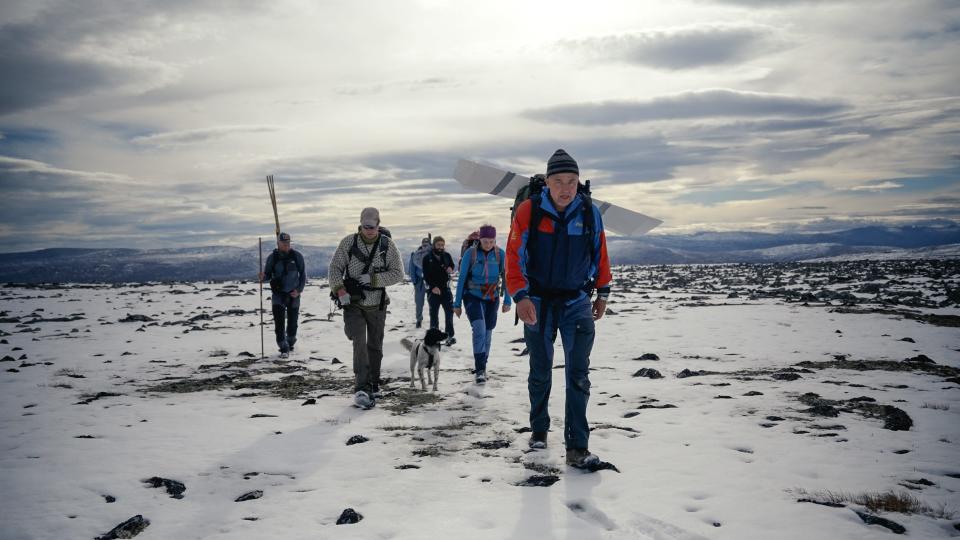-
Norway’s melting glaciers are revealing objects from the Stone Age, the Iron Age, and the medieval era.
-
Some ancient artifacts are mysteries, but they still indicate trade routes through the mountains.
-
Here’s what Norway’s glacial archaeologists found in the meltiest part of this past summer.
Mysterious and fascinating artifacts are surfacing on melting glaciers across the planet.
From strange wooden tools and statues to ancient human remains, these objects are drawing archaeologists into the high, frozen mountains each year.
Norway is at the forefront of this emerging field of research, called glacial archaeology. With about 4,500 artifacts discovered, the country claims more than half of the planet’s glacial archaeology findings, according to Espen Finstad, who co-leads the Norwegian program, called Secrets of the Ice.
Advertisement
Advertisement
Archaeologists there are piecing together clues about ancient industries and trade routes across the glaciers.
They just had one of their best field seasons yet. Here’s what they found.
People have trekked over Norway’s glaciers for thousands of years to sell and buy goods.

Espen Finstad leading a team of archaeologists on a three-hour hike to a dig site.Andreas Christoffer Nilsson, secretsoftheice.com
Ancient hunting, travel, and trade routes crossed the mountains between the Norwegian coast and inland areas from the Stone Age.
“We are lucky that some of these trade routes have gone over ice,” Finstad told Business Insider.
Objects that ancient travelers left behind were frozen in the ice for centuries — until recent decades.

A 1700-year-old horse snowshoe was found on the ice at Lendbreen.Glacier Archaeology Program
As humans have burned fossil fuels for energy, releasing heat-trapping gases into the atmosphere, global temperatures have been rising for decades. Glaciers everywhere are melting, releasing the ancient artifacts preserved inside them.
Advertisement
Advertisement
Some of these objects look familiar, such as this mitten.

An ancient mitten, which looks just like a modern one.Johan Wildhagen/Palookaville
Others, such as this whisk, are quite different from what we know today.

Yes, the archaeologists believe this was a whisk.Innlandet County Municipality, Secrets of the Ice
Advertisement
Advertisement
More in Science
The Lendbreen ice patch is the most fruitful site the archaeologists visit.

The Lendbreen ice patch in 2006, top, and 2018, bottom.Espen Finstad, secretsoftheice.com
“There are so many treasures in the ice there,” Finstad said.
Lendbreen was a common travel route during the Viking and medieval eras. The archaeologists go there almost every year.
In the summer of 2024, heavy melting meant lots of new discoveries.

The Lendbreen ice patch as it looked when the team arrived in September.Espen Finstad, secretsoftheice.com
“The melting really came rapidly at the end of the season,” Finstad said.
Finstad’s team of about seven archaeologists visited nearly a dozen sites across the mountains to search for artifacts.

A team member admiring a freeze-dried arrow shaft.Glacier Archaeology Program, Innlandet County Council
At Lendbreen, they used pack horses to bring gear up to the site and set up their camp.

Packhorses help the archaeologists bring gear to their study site.Innlandet County Municipality, Secrets of the Ice
Advertisement
Advertisement
They stayed there about nine days, Finstad said.
Their findings included “two of the best-preserved arrows we ever found,” Finstad said.

A 1300-year-old arrow as it was found lying on the ice at the Lendbreen ice patch in Innlandet County, Norway.Espen Finstad, secretsoftheice.com
One of them was just lying on top of the ice, waiting to be found. Usually there’s a little excavation involved, but the archaeologists simply picked this arrow up.
“It’s very seldom to find them that well preserved on the ice. So it was kind of a gift. It was very beautiful,” Finstad said.
Arrows are abundant in the glaciers because reindeer hunting was “almost like an industry” in the Iron Age and medieval era, Finstad said.

Reindeer move to the ice and snow in summer to avoid botflies. This provided an opportunity for ancient hunters.Glacier Archaeology Program, Innlandet County Council
People hunted for their own food, of course, but also to sell in a market.
Advertisement
Advertisement
Arrows can hold clues about past societies.

A member of the Secrets of the Ice team holding an Iron Age arrow shaft and its arrowhead.Espen Finstad, secretsoftheice.com
For example, some arrowheads found on the glaciers have tips made from river mussels that must have come from far away, cluing researchers in to just how far people were traveling and trading over the ages.
Some of the prehistoric arrows Finstad’s team found last season were so well-preserved they still had fletching.

A 1500-year-old arrow found at the Storgrovbrean ice patch with preserved fletching.Museum of Cultural History
Advertisement
Advertisement
Fletching is delicate and doesn’t usually last thousands of years. These were rare findings.
Some items they find are just “strange,” Finstad said.

Archaeologists found this small wooden object on the Lendbreen pass. They don’t know what it is.Kathrine Stene, secretsoftheice.com
Small bits of wood, leather, and textile are often impossible to identify.
Finstad estimated they’d found about 50 small, mysterious objects at Lendbreen in 2024.

An object of leather or hide with visible seams, possibly a shoe, found at Lendbreen.Øystein Rønning Andersen, secretsoftheice.com
“It’s all kind of small things, daily life things from the Viking Age or older, which you don’t find in other archaeology contexts, at least in Norway, because it’s gone. It degrades,” Finstad said.
Heavy snow cut off the archaeologists’ efforts — but now they know where to look this summer.

A medieval horseshoe found on the Lendbreen ice patch.May-Tove Smiseth, secretsoftheice.com
“We are excited to go back,” Finstad said.
Read the original article on Business Insider
EMEA Tribune is not involved in this news article, it is taken from our partners and or from the News Agencies. Copyright and Credit go to the News Agencies, email news@emeatribune.com Follow our WhatsApp verified Channel




